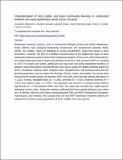| dc.description.abstract | Wastewater treatment systems, such as Constructed Wetlands (CWs) and Waste Stabilization Ponds (WSPs), have untapped biodiversity enhancement and development potential. Birds, insects, and reptiles, which are displaced by human development, might find refuge in these ecosystems. However, the lack of a detailed characterization of the biodiversity status of these wastewater treatment systems hinders their widespread adoption. Point counts, direct observations, and camera traps were used to assess bird diversity across five CWs and three WSPs in Tanzania in 2021. For insects and reptiles, pitfall and pan traps were laid along established transects, in addition, direct observations and fishnets were also used to assess the reptiles dwelling within the WSPs. Abundance, Shannon index, Simpson index, Margalef index, and evenness index were the diversity parameters used to analyze the diversity of birds, insects, and reptiles. Our results show that among the studied groups and between WSPs and CWs, birds had high species abundance (n = 1132), richness, Margalef index (D = 4.266), evenness (E = 0.815), Shannon diversity (H = 2.881) and Simpson index (λ =0.903). The abundance and diversity of studied groups differed significantly (P < 0.05) between WSPs and CWs. Our study also recorded four reptile species belonging to three orders. Molecular analyses confirmed that insect species belong to nine orders and 13 families, with the order Diptera dominating both CWs and WSPs, followed by Orthoptera, Hymenoptera, and Araneae. We conclude that CW and WSP wastewater treatment systems are important for hosting various populations of birds, reptiles, and insect species. | en_US |

